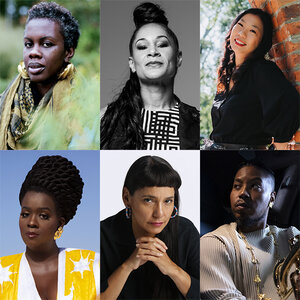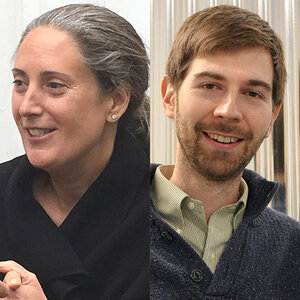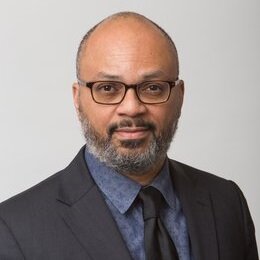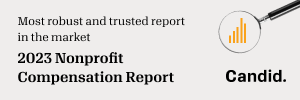Sam Gill, President, Doris Duke Foundation: Supporting the whole artist and making pluralism work
February 14, 2023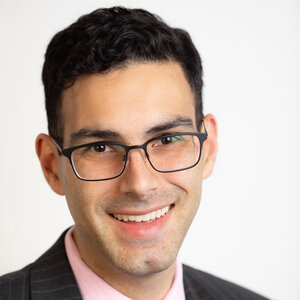
Sam Gill became the third president of the Doris Duke Foundation (DDF) in April 2021, directing the activities of the $2.6 billion foundation with national grantmaking programs focused on medical research, the environment, child well-being, mutual understanding between communities, and the performing arts.
Before joining DDF, Gill—a Minnesota native, University of Chicago graduate, and Rhodes Scholar—was senior vice president and chief program officer at the John S. and James L. Knight Foundation.
PND spoke with Gill on the occasion of the 10th anniversary of the Doris Duke Artist Awards. Beginning this year, recipients will receive an unrestricted grant of $550,000, double the amount of earlier awards, while the 129 previous recipients will each receive a $20,000 grant as part of a transformation of the award from a “series of winners” to an engaged and active community.
PND asked Gill about the artist awards, their evolution, and the changing landscape of arts philanthropy. We also asked about the effects of the pandemic across the foundation’s programming and how that and George Floyd’s murder have helped center and accelerate social and economic justice in the foundation’s work.
Philanthropy News Digest: This year is a big deal for the Doris Duke Artist Awards, both because this is the 10th anniversary of the program and because the foundation is doubling the award. Let’s start with this year's recipients and how they connect to the evolution of the arts in the past decade and the direction the foundation is taking.
Sam Gill: I couldn't think of a more perfect class to exemplify both what the award stands for in a timeless and perennial way and to exemplify the evolution of the award. On the one hand, this is a colorful, eclectic, accomplished group that is producing riveting creative work at the highest standard. That’s where you want to see absolute consistency from year to year. On the other hand, you also want to see a group of artists that you never would have imagined 10 years ago—when DDF started the award—as the people who are being celebrated. And that’s because the Doris Duke Artist Awards aren’t meant to defend the ramparts of the status quo or a fixed idea of what artistic excellence is. Instead, it’s like a mirror being held up to artists and what they do best—pushing forward in what they do, how they do it, why they do it, who they're doing it for.
There’s people like Chief Xian aTunde Adjuah, a widely recognized, award-winning, experimental jazz artist; Ayodele Casel, who is a critically acclaimed tap dancer and choreographer; Somi [Kakoma], who is so well regarded, she’s known by that mononym. There’s also, within this group, the kind of evolution in method, the kind of evolution in practice, the kind of evolution in subject that I think really speaks to the way that the Doris Duke Artist Awards are—like the arts themselves—not static. They move with the arts and they move at the leading edge of the arts. So there’s people like Charlotte Braithwaite, an extraordinarily convention-defying theater artist, and Rosy Simas, who is an enrolled member of the Seneca Nation and who, in her works of dance, is trying to help our country and communities to confront really challenging and different ideas—all through this idea of movement and the different ways that we can experience and understand movement. And then there is Kristina Wong, who is hilarious, and is finding the sublime and the satirical in unbelievably creative places. Not only does she do more conventional performance art in theaters, but she also created a work called Kristina Wong for Public Office, where she actually served on a neighborhood association as a work of art.
PND: So the awards are about asking new questions about art, about what art represents. How has that changed over the past decade?
SG: One thing we say all the time here about the Doris Duke Artist Awards is: “When artists thrive, we all thrive.” The award is intended to do three things. One is to support the work of exciting, excellent, transformational artists to accelerate and to amplify and to grow. The second thing is to demonstrate, through unrestricted support, how we as a society could benefit from the kinds of artistic expression—the kinds of creativity that could be unlocked—if an artist as a whole person is supported. And the third thing is to push that argument further and further and further and to say it louder and louder so that, indeed, we might be able to invest in the arts and assign an economic value to the arts—and to the well-being of the artist—that’s commensurate with the social value that we assign to the arts.
One of the most profound and important roles that the arts play in our society is to help us confront the questions that are so new and so difficult and so wrenching that we can’t confront them in conventional ways...So the question we have to ask as a society is: How do we make more commonplace the rare singularity of an individual artist and their ability to help us confront these questions?
The Doris Duke Artist Award and the artists it recognizes evolve, because that’s what the arts do for our society—they evolve with the society. One of the most profound and important roles that the arts play in our society is to help us confront the questions that are so new and so difficult and so wrenching that we can’t confront them in conventional ways. We can’t have a reasonable conversation about them in the political sphere. We don’t know how to tackle these questions in the economic sphere. We might not have the words in the language to work these things out in the social sphere. But through arts, we can confront these questions and we can confront them in productive ways, in liberating ways, and exciting ways, and every single Doris Duke Artist demonstrates that power in their work. So the question we have to ask as a society is: How do we make more commonplace the rare singularity of an individual artist and their ability to help us confront these questions? How do we make that an abundant experience that anybody can access all of the time?
PND: For years the performing arts have been in perilous financial straits that have only been made worse by the COVID-19 pandemic, shifting philanthropic priorities, and consumer tastes. How do you see the landscape of arts philanthropy changing?
SG: Here’s two things that have never changed: One is the power of great art to move us and to change the way we see the world; the other thing that’s never changed—and it should change—is our undervaluing of the arts. It is true that certain funding streams for the arts are in peril. It is true that certain ways of encountering the arts, in particular the performing arts, are potentially fading or deteriorating—and we need to think about how to protect those activities and those institutions where they’re important. But we can’t make the mistake of thinking the arts have ever been sufficiently supported, that artists have ever been sufficiently supported.
There are a few motifs that are as widely recognized as the motif of the starving artist. Well, we shouldn’t need the starving artist, because if fewer artists were starving, the arts would be more abundant. And I think, as the Doris Duke Artist Awards demonstrate, if fewer artists were starving, then the artistic production that they offer to the world would be even greater, would be even more innovative, would be even more sublime.
We’re in a moment where we’re facing two kinds of economic challenges in the arts. One is that the provision of certain kinds of public goods are imperiled in a lot of different fields, whether that’s the arts, or education, etc. A second economic challenge is that one particular way of bringing the arts to audiences is also in peril. The big-box venue model, where earned revenue through tickets was keeping the venue open, that’s also in peril. Those are the economic pressures. There are also social pressures. Every institution in our society is having to ask really hard questions about what the real demands and obligations of justice are, particularly around questions of race, questions of gender and gender identity and sexuality, and the arts are not exempt from this. And to the extent that we live in a society suffused with the stain of racism, of sexism, of other kinds of discrimination, so, too, our arts institutions and arts organizations are suffused with those same vices.
The opportunity we face is that the economic crisis and the social crisis are happening at the same time. The question we can ask now is: OK, let’s put aside our pieties about the way art is supposed to be presented, or the way art is supposed to be made. Instead, let’s ask who has a great vision for how to deliver the benefit of the arts in ways that are conducive to our highest ideals about what a just society looks like, who can provide the benefit of the arts in ways that might attract new forms of revenue or new forms of attention, new forms of support.
For example, Long Wharf Theatre Company in New Haven, Connecticut, a Doris Duke grantee, has a subscription model they tried out over the pandemic where they gave access to performances in a way that was like a library card. Someone could borrow a membership for a period of time, and then give it back, and it could go to someone else. That’s not a revenue stream in and of itself, but it’s a great way to experiment with how to be essential to a community. While we might be lessening public investment in the arts, properly speaking, that kind of model can help an arts organization to attract other kinds of revenue as community members begin to see that organization’s value to a different part of the community in a new way—a part of the community, by the way, that before had probably been excluded from the traditional subscription and ticketing model. So that’s one way an economic experiment and a social experiment—both confronting the real questions that arts presenting institutions face—can come together.
The good news is that individual artists are going to continue to produce incredible work that delivers all the great benefits of the arts. So really, the question we face is: How can we make institutions and funding streams flexible and evolutionary in ways that can support the perennially great and inventive work of artists?
PND: This year, in addition to doubling the award, DDF is making special grants to previous recipients and has reserved $30 million for future awards. What is your thinking behind these changes and what does this new strategy signal to the arts community?
SG: Our hypothesis is: “When the arts thrive, when artists thrive, we all thrive.” The first part of the hypothesis, which we think we spent the last 10 years proving, is that providing unrestricted support to individual performing artists, giving the artist control over what the money could be used for—whether to move their work forward or to buy a house or travel, or study, or save for retirement—the first part of the hypothesis was to figure out whether we could unlock new creative possibilities and new creative potential. I think the answer to that part of the hypothesis, based on the last 10 years and 129 previous recipients, is a resounding “Yes.” These artists have been among the most important, vital, innovative members of their fields and of their disciplines.
The second part of the hypothesis is, how can we elevate that argument more widely? How can we demonstrate to policy makers, to decision makers, to arts patrons and funders, to audiences, that the whole artist needs to thrive in order for our society to obtain the greatest possible benefit of the creativity and vision that artists are offering to us?
How can we demonstrate to policy makers, to decision makers, to arts patrons and funders, to audiences, that the whole artist needs to thrive in order for our society to obtain the greatest possible benefit of the creativity and vision that artists are offering to us?
What is that going to look like? It’s going to look like a larger award, in part, so that we can continue to elevate individual artists. It’s also going to look like a much more active community of Doris Duke Artists. We looked around 10 years in and thought: This is a community. It’s not just a series of award winners, it’s one of the greatest living communities of performing artists. No one is a better advocate for the power of the arts and society than these 129 people; no one has more insight into what artists truly need, and other ways that those needs can be met, than these 129 people. So partly what we’re going to do is invest in building and supporting and nurturing that community and the [newly announced] $20,000 grants to the living [previous recipients] in some ways are our recognition that they didn’t just win an award in the past; they’re an enduring part of a community as Doris Duke Artists, and we want to recognize that by continuing to invest in their work and in their fellowship.
What it will also look like is a whole new set of activities under the aegis of the Doris Duke Artist awards to make that argument. You’re going to see us put out research about what it looks like to support the fundamental conditions of creativity. You're going to see the Doris Duke Artists appear at conferences under the banner for bringing together important conversations between artists and presenting organizations and other interested stakeholders. It’s going to look like a much wider and more creative range of activity intended to connect the first part of the hypothesis—when you can invest in the artist as a whole person—to the second part of the hypothesis—that we as a society can make this investment at a much larger scale and therefore produce incredible benefits for all of us.
PND: DDF made a commitment of $100 million in 2022 to boost arts funding both as a response to the COVID-19 pandemic and to accelerate social justice initiatives in the wake of George Floyd’s murder. How is that going, and can you share any near-term results? Will we see more investments like this in the future?
SG: Through the Ford Foundation’s leadership, we also borrowed $100 million against our endowment during the pandemic. We took a slightly different approach than some of the other foundations. Some of the resources were invested immediately in relief. For example, we invested in critical arts organizations that provide valuable infrastructure and services to the field that were suffering financially. We have a program in child well-being, and we invested in human services organizations in key places to help them to continue to provide direct services. We provide career support for physician-scientists, and we invested in researchers who were facing lab closures and remote work—things that were delaying research, in some cases, research that was vital to helping our society respond to COVID-19. So we did make some emergency relief investments, but we also took a step back and said: The reality is that COVID is having a trillion-dollar impact on our country alone and a much larger impact on the rest of the world, and ultimately governments are going to have to make the investments in our country, in our communities, in order to fully recover.
What COVID has opened up is a whole set of questions that were off the table in every field that we were working in. Some of those were questions that we didn’t understand or didn’t think to ask. For example, everyone moving to remote work in one day in March of 2020 helped organizations in every sector of the economy to see how inadequately we were supporting caregivers in this country—with kids running across Zoom screens, or elderly relatives or others in the background—and seeing people literally trying to juggle all that. With our investments in career support for physician-scientists focused on building a more equitable and inclusive biomedical research field, we recognized that one of the big impediments to a successful career in biomedical research, which is very labor-intensive, is having adequate support for caregiving. Before COVID these had been taboo discussions in research departments at medical schools and at research universities, but in this moment everyone was beginning to see that this was a problem across the whole workforce. Women were suffering disproportionately, people of color were suffering disproportionately, but everyone was grappling with this issue and had a greater sensitivity and awareness.
We thought this was a great opportunity to make this a more robust topic of conversation in biomedical departments, so we got together with six other foundations, drew on some of our bond-allocated resources—the other foundations more than doubled that money—and we invested $12.1 million in a collaborative that was intended to support almost two dozen different medical research departments, helping to meet caregiving needs in ways that could preserve research projects and therefore keep research careers on track. But that was all about taking on a question that we were able to ask in the context of COVID.
In other ways, COVID has accelerated longstanding trends and created a newfound urgency to respond them. Over the next year, you’re going to see us announce investments from our social impact bond that are taking on those sorts of questions that were simmering beneath the surface, but the way in which COVID brought them to the surface has created a newfound energy that we think we could leverage with targeted investments. Questions around the arts and what the performing arts are going to look like in the new century in the context of digital technology. Questions around environmental conservation, and how to enable that movement to be far more inclusive than it’s been in the past with regard to race. Questions in medicine that take on directly the relationship between biomedical research and the kinds of disparities and health outcomes that we now see plainly and regard as intolerable as a result of the experience of COVID-19. The big question we’ve been asking is: How can we leverage and respond to the direct and indirect effects of COVID-19 in order to advance our mission in generational ways and to take generational leaps in moving social change forward?
The big question we’ve been asking is: How can we leverage and respond to the direct and indirect effects of COVID-19 in order to advance our mission in generational ways and to take generational leaps in moving social change forward?
PND: You are only the third president of DDF in 27 years, following Joan Spero and Ed Henry. What opportunities and challenges do you face today that differ from those of your predecessors, and what do you hope to see as your own legacy a decade from now?
SG: The opportunity is to leverage and take advantage of the incredible platform Joan and Ed built. Joan had to oversee the liquidation of the [Doris Duke] estate, over which there had been a very contentious settlement. So first she had to create the asset base for the foundation out of the estate, and then she had to set up a foundation. She really ran a startup, and her challenge was creating something from nothing. I think what Ed had to do was to take that something and had to resolve some really complicated questions—in addition to running a grantmaking program, we own and operate two centers that serve the public that were Doris Duke’s estates. Turning those from homes into vital and contemporary and relevant centers was a really big task and required a lot of capital projects and required a lot of programmatic imagination, Ed had to take that “something” and really institutionalize it into a rigorous and repeatable program.
The opportunity is that the work has been completed. This is a really well-oiled machine and the opportunity is to see how fast it can go and how far it can go, how we can build on that incredible foundation and take advantage of our now well-established professional acumen and operational integrity.
The challenge has to do with the world that we live in today. We live in a world where no foundation is relevant just because of its size. Size and the flexibility of capital gives you a lot of advantages, but how can we be relevant and meaningful and essential to the fields in which we work? That is a harder question to answer today than it was in 1996, when DDF was one of the largest foundations in the country. Today it’s still very large, but it’s not one of the handful of the largest. Broadly, it’s an even harder question to answer than it was 50, 60, 100 years ago, when there were only a few foundations—and boy, they were real behemoths compared to the fields in which they were working.
Another challenge is that the marketplace of ideas has become much more crowded and confusing and competitive. Now, it’s not just about different foundations or different civil society organizations jockeying, collaborating to bring important, necessary ideas into the world. You’re now competing with all kinds of different media properties, with all kinds of different independent voices. And that competition is global and 24/7. The cycle rate of innovation has increased. It’s not just that the world is different today than it was in 1996; it’s that the world is vastly different and the rate at which it’s changing is much faster. And we have to keep up with that.
Foundations cannot have an impact on the basis of their investments alone. It’s easy to give money away to do good things. What’s difficult to do is to give money away in a narrow area that has a larger impact that reverberates more widely than the individual investment that you make. That process of identifying a narrow set of investments that are significant to a wider problem and can have a wider reach and a wider influence in their effects relies upon really understanding and anticipating changes in individual fields and wider changes in the social, political, and economic organization of the society. As those changes happen more quickly and in more complex ways that job becomes exponentially harder.
PND: How has your upbringing in Minnesota, your family, and education, as well as your experience at the John S. and James L. Knight Foundation, informed the work you do at DDF?
SG: The Knight Foundation is run by a visionary leader in this field, Alberto Ibargüen, who came out of the media business, and he really ran that foundation as a media company. He didn’t see the grant as the product we were running off the assembly line. He ran the foundation as if what we were trying to do was provide useful ideas to the world and to make those ideas essential to the audiences and the communities that needed them, and we had all kinds of tools at our disposal to do that. Some of those tools were grantmaking tools, but the other tools were our investments in the endowment, our ability to bring people together, or our ability to inject our own voice into the conversation. That left a profound impact on me.
I grew up in Minnesota. My dad is from India, my mom is from the Midwest, and I have one older brother who has Down syndrome. I grew up in an affluent, mostly white, suburb of Minneapolis with a dad who had a turban and looked visibly different, and a brother who didn't have formal civil rights until the Americans with Disabilities Act was passed 1991, when he was 12 years old.
When that works—when differences that acute do not impact the distribution of opportunity, the distribution of privilege, the rights and entitlements that people enjoy—our democracy works. And when that doesn’t work, our democracy fails. We are in a moment now where we’re asking really existential questions about our democracy. Those questions are around the question of how we live together—with differences like race and gender—and ensure that those differences do not have a moral impact on the quality of life that someone gets to enjoy or the rights that someone has. We’re living at a time when some people feel that giving rights and enabling opportunity for some people takes away their own rights and opportunities.
That process of negotiation of difference had to work for my family in Minnesota. The thing is that we’ve got to make that work across the country.
I think about that every day at Doris Duke. How can we be a part of making democracy work? How do we make pluralism work?
Minnesota is famous for having a strong tradition of independent philanthropy from corporations, from individuals, from faith traditions and communities, and that philanthropy has funded an incredibly diverse and vibrant civil society. Minneapolis is a town in the middle of the prairie that has some of the best theater in the country, some of the best performing arts and music in the country, some of the finest museums of visual art in the country, an extremely strong human services and social sector that has been an innovator time after time in finding ways for communities to govern themselves differently and to solve problems differently than other place places in the country. It’s historically been a hotbed of mavericks, from Hubert H. Humphrey to Eugene McCarthy to Wendy Thompson to Paul Wellstone to Roy Wilkins—and people like Rosy Simas, one of our newest Doris Duke Artists.
I think there’s a lot that’s wrong with Minneapolis; everyone learned that after the murder of George Floyd. There’s a hell of a lot wrong. The challenges of really confronting systemic racism, of confronting what it means to live in a country that is just within this generation, just across generations, and just with respect to future generations, to live in a country that will be defined by how effectively it manages interdependence across the world is daunting.
Minneapolis has all the same problems that we’ve got everywhere in the country, but it also is a great example of what has been our country’s solution over time, which is to have a really strong and vigorous and well supported civil society. I got to grow up in a place where I saw that work and I believe that it can work for the challenges that we face.
The thing that has to make you optimistic about the United States and what’s so powerful about our civil society is that it evolves, that its strength is not trying to solve the same old problems in the same old way but adapting itself to the way the problems are changing, to the way the questions are changing, to new expectations, and finding innovative ways to answer those new questions in new ways.
If you put all those things together, I think the real challenge for philanthropy is how to invest in and advance contemporary, relevant, and important ideas that can animate and drive this country’s incredible civil society in ways that make pluralism work. In a changed and changing world, it’s a lot easier to say that, than to do it, but you can't do it if you can't say it. That's what our opportunity and our obligation is at Doris Duke.


